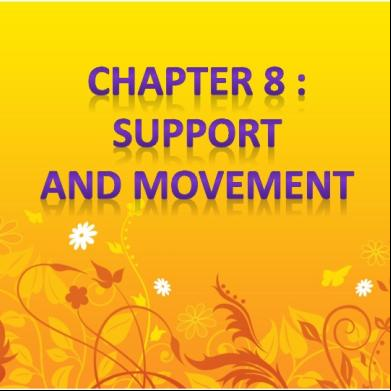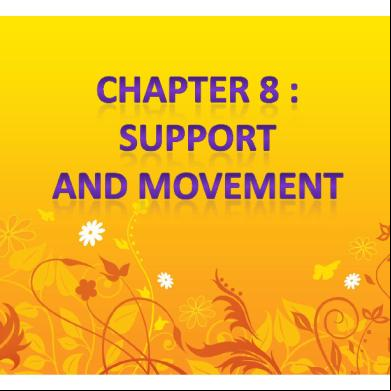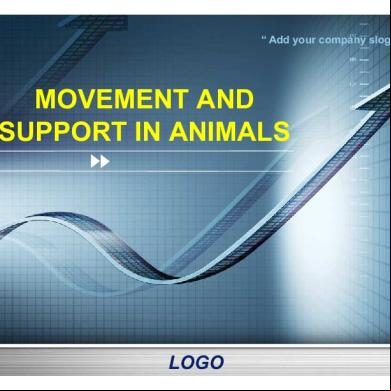50364228 System In Animals And Plants 20585
This document was ed by and they confirmed that they have the permission to share it. If you are author or own the copyright of this book, please report to us by using this report form. Report 3i3n4
Overview 26281t
& View 50364228 System In Animals And Plants as PDF for free.
More details 6y5l6z
- Words: 712
- Pages: 37
system in humans and animals is called SKELETON or SKELETAL SYSTEM ENDOSKELETON
3 types of skeletal systems EXOSKELETON
HYDROSTATIC SKELETON
ENDOSKELETON • Inner Frame • Refers to bones or cartilage that is inside the body of vertebrates.
EXOSKELETON • Outer Frame • Consists of one layer of hard skin derived from substances like calcium carbonate
HYDROSTATTIC SKELETON • Formed from fluid pressure in space that is enveloped by a muscular system.
body weight
Protects soft organs inside body
Maintain body shape Provide place for muscles in body to attach themselves
Enable limbs to move
body weight
Protects soft tissues from damage
Maintain body shape Provide surface for muscles to attach themselves
Allow movement
Endoskeleton in humans consists of 206 bones
Backbone mainly ed by Pelvic Girdle
Pelvic Girdle : strongest bone in human body
ANIMALS
Vertebrates
Land
Aquatic
Invertebrates
Exoskeleton
Hydrostatic Skeletal
Entire weight is ed by its endoskeleton. Skeletal system : bigger and stronger than that of the aquatic animal vertebrate system.
Big land animals : Strong and big Pectoral and Pelvic Girdles to their body weight Four-legged animals : Backbone either curve upwards or downwards. Enables backbone to withstand any heavy load acting on the animal.
Pectoral Girdle
Pelvic Girdle
Birds : Have hollow bones and air spaces inside so that the body is lighter. Advantages of hollow bones : Lighter Requires less calcium and phosphorous for its formation.
Examples : Whales, dolphins Smaller and lighter endoskeleton than land vertebrates. Pectoral and pelvic that is smaller and lighter. Most of body weight is ed by buoyancy of the water.
The buoyancy of the water allows the size of the aquatic vertebrate animals to be bigger that land vertebrate animals.
ENDOSKELETON
SIMILARITIES PECTORAL AND PELVIC GIRDLE
VERTEBRATE BONES ARE FLEXIBLE
IN LAND VERTEBRATES
DIFFERENCES
IN AQUATIC VERTEBRATES
Pectoral and pelvic girdle the body weight
Water buoyancy s the body weight
Big and strong
SKELETON
Small and weak
Big
PECTORAL AND PELVIC GIRDLE
Small
Invertebrates are animals that do not have a backbone. Its body is ed by : External skeletal system (exoskeleton) Body fluids (hydrostatic skeletons)
Exoskeleton consists of a layer of hard skin or shell. Examples of invertebrates with hard outer skin : Crabs, spiders, prawns and scorpions. Examples of invertebrates with hard shell : Snails, mussels
For insects, the exoskeleton is called cuticle. Cuticle is made of chitin (hard and impermeable to water) Cuticle prevent the insects from growing.
Leeches, worms and octopus do not have exoskeleton. Their bodies are soft. Use the body fluid (also known as hydrostatic skeleton system) as system.
The body fluids exert a pressure on their body walls to form a hydrostatic skeleton.
EXOSKELETON
SIMILARITIES
BODY FLUID
IN LAND INVERTEBRATES
DIFFERENCES
IN AQUATIC INVERTEBRATES
Soft bodies with external shells
Water buoyancy
SKELETON
Hard and made of calcium carbonate, for example, crabs.
Hard and made of chitin, for example, insects.
system of plants are different based on the type of plant.
PLANTS
Land
Woody
Aquatic
Non-woody (herbaceous)
Examples: rubber tree, durian tree, rambutan tree, and teak tree. ed by woody tissues. Woody tissues – dense, hard on tree trunk. - made up of xylem tissues. Most of the woody plants are tall.
Also ed by special structures : Buttress roots Clasping roots
Examples: durian trees, casuarina trees, and yellow flame trees. Occurs at the base of the trunk where the main roots branch off at the ground surface and enter the soil.
Examples : money plant, certain wild orchid. Enable a plant to climb by growing around and clasping its .
Examples: roses, bougainvillea. ed by turgid cells.
Water is absorbed by the cells
Pressure is exerted on the cell walls
Stem being turgid
Also ed by special structures : Thorns Tendrils Prop Roots (Adventitious Roots)
IN HERBACEOUS PLANTS
DIFFERENCES
IN WOODY PLANTS
Pectoral and pelvic girdle the body weight
Water buoyancy s the body weight
Big and strong
SKELETON
Small and weak
Big
PECTORAL AND PELVIC GIRDLE
Small
Examples: yam, water lily and lotus. ed by water buoyancy. Have soft stems that have air space and their leaves broad with stomata on the surface. Aquatic plants that live in the water have fine leaves.
3 types of skeletal systems EXOSKELETON
HYDROSTATIC SKELETON
ENDOSKELETON • Inner Frame • Refers to bones or cartilage that is inside the body of vertebrates.
EXOSKELETON • Outer Frame • Consists of one layer of hard skin derived from substances like calcium carbonate
HYDROSTATTIC SKELETON • Formed from fluid pressure in space that is enveloped by a muscular system.
body weight
Protects soft organs inside body
Maintain body shape Provide place for muscles in body to attach themselves
Enable limbs to move
body weight
Protects soft tissues from damage
Maintain body shape Provide surface for muscles to attach themselves
Allow movement
Endoskeleton in humans consists of 206 bones
Backbone mainly ed by Pelvic Girdle
Pelvic Girdle : strongest bone in human body
ANIMALS
Vertebrates
Land
Aquatic
Invertebrates
Exoskeleton
Hydrostatic Skeletal
Entire weight is ed by its endoskeleton. Skeletal system : bigger and stronger than that of the aquatic animal vertebrate system.
Big land animals : Strong and big Pectoral and Pelvic Girdles to their body weight Four-legged animals : Backbone either curve upwards or downwards. Enables backbone to withstand any heavy load acting on the animal.
Pectoral Girdle
Pelvic Girdle
Birds : Have hollow bones and air spaces inside so that the body is lighter. Advantages of hollow bones : Lighter Requires less calcium and phosphorous for its formation.
Examples : Whales, dolphins Smaller and lighter endoskeleton than land vertebrates. Pectoral and pelvic that is smaller and lighter. Most of body weight is ed by buoyancy of the water.
The buoyancy of the water allows the size of the aquatic vertebrate animals to be bigger that land vertebrate animals.
ENDOSKELETON
SIMILARITIES PECTORAL AND PELVIC GIRDLE
VERTEBRATE BONES ARE FLEXIBLE
IN LAND VERTEBRATES
DIFFERENCES
IN AQUATIC VERTEBRATES
Pectoral and pelvic girdle the body weight
Water buoyancy s the body weight
Big and strong
SKELETON
Small and weak
Big
PECTORAL AND PELVIC GIRDLE
Small
Invertebrates are animals that do not have a backbone. Its body is ed by : External skeletal system (exoskeleton) Body fluids (hydrostatic skeletons)
Exoskeleton consists of a layer of hard skin or shell. Examples of invertebrates with hard outer skin : Crabs, spiders, prawns and scorpions. Examples of invertebrates with hard shell : Snails, mussels
For insects, the exoskeleton is called cuticle. Cuticle is made of chitin (hard and impermeable to water) Cuticle prevent the insects from growing.
Leeches, worms and octopus do not have exoskeleton. Their bodies are soft. Use the body fluid (also known as hydrostatic skeleton system) as system.
The body fluids exert a pressure on their body walls to form a hydrostatic skeleton.
EXOSKELETON
SIMILARITIES
BODY FLUID
IN LAND INVERTEBRATES
DIFFERENCES
IN AQUATIC INVERTEBRATES
Soft bodies with external shells
Water buoyancy
SKELETON
Hard and made of calcium carbonate, for example, crabs.
Hard and made of chitin, for example, insects.
system of plants are different based on the type of plant.
PLANTS
Land
Woody
Aquatic
Non-woody (herbaceous)
Examples: rubber tree, durian tree, rambutan tree, and teak tree. ed by woody tissues. Woody tissues – dense, hard on tree trunk. - made up of xylem tissues. Most of the woody plants are tall.
Also ed by special structures : Buttress roots Clasping roots
Examples: durian trees, casuarina trees, and yellow flame trees. Occurs at the base of the trunk where the main roots branch off at the ground surface and enter the soil.
Examples : money plant, certain wild orchid. Enable a plant to climb by growing around and clasping its .
Examples: roses, bougainvillea. ed by turgid cells.
Water is absorbed by the cells
Pressure is exerted on the cell walls
Stem being turgid
Also ed by special structures : Thorns Tendrils Prop Roots (Adventitious Roots)
IN HERBACEOUS PLANTS
DIFFERENCES
IN WOODY PLANTS
Pectoral and pelvic girdle the body weight
Water buoyancy s the body weight
Big and strong
SKELETON
Small and weak
Big
PECTORAL AND PELVIC GIRDLE
Small
Examples: yam, water lily and lotus. ed by water buoyancy. Have soft stems that have air space and their leaves broad with stomata on the surface. Aquatic plants that live in the water have fine leaves.





